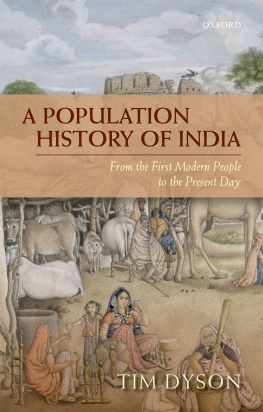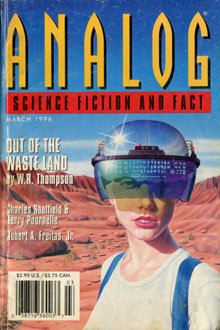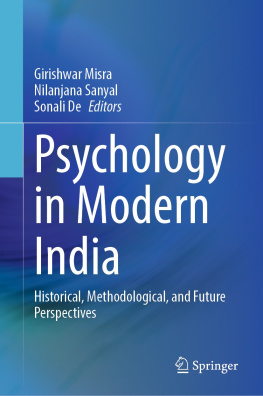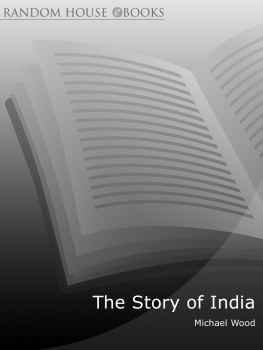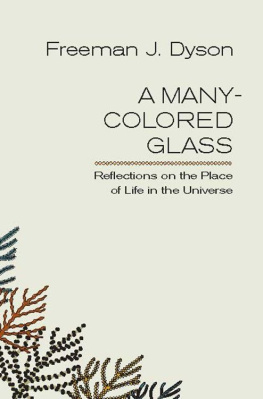Tim Dyson - A population history of India - From the First Modern People to the Present Day
Here you can read online Tim Dyson - A population history of India - From the First Modern People to the Present Day full text of the book (entire story) in english for free. Download pdf and epub, get meaning, cover and reviews about this ebook. year: 2018, publisher: Oxford University Press, genre: Religion. Description of the work, (preface) as well as reviews are available. Best literature library LitArk.com created for fans of good reading and offers a wide selection of genres:
Romance novel
Science fiction
Adventure
Detective
Science
History
Home and family
Prose
Art
Politics
Computer
Non-fiction
Religion
Business
Children
Humor
Choose a favorite category and find really read worthwhile books. Enjoy immersion in the world of imagination, feel the emotions of the characters or learn something new for yourself, make an fascinating discovery.
A population history of India - From the First Modern People to the Present Day: summary, description and annotation
We offer to read an annotation, description, summary or preface (depends on what the author of the book "A population history of India - From the First Modern People to the Present Day" wrote himself). If you haven't found the necessary information about the book — write in the comments, we will try to find it.
Tim Dyson: author's other books
Who wrote A population history of India - From the First Modern People to the Present Day? Find out the surname, the name of the author of the book and a list of all author's works by series.
A population history of India - From the First Modern People to the Present Day — read online for free the complete book (whole text) full work
Below is the text of the book, divided by pages. System saving the place of the last page read, allows you to conveniently read the book "A population history of India - From the First Modern People to the Present Day" online for free, without having to search again every time where you left off. Put a bookmark, and you can go to the page where you finished reading at any time.
Font size:
Interval:
Bookmark:

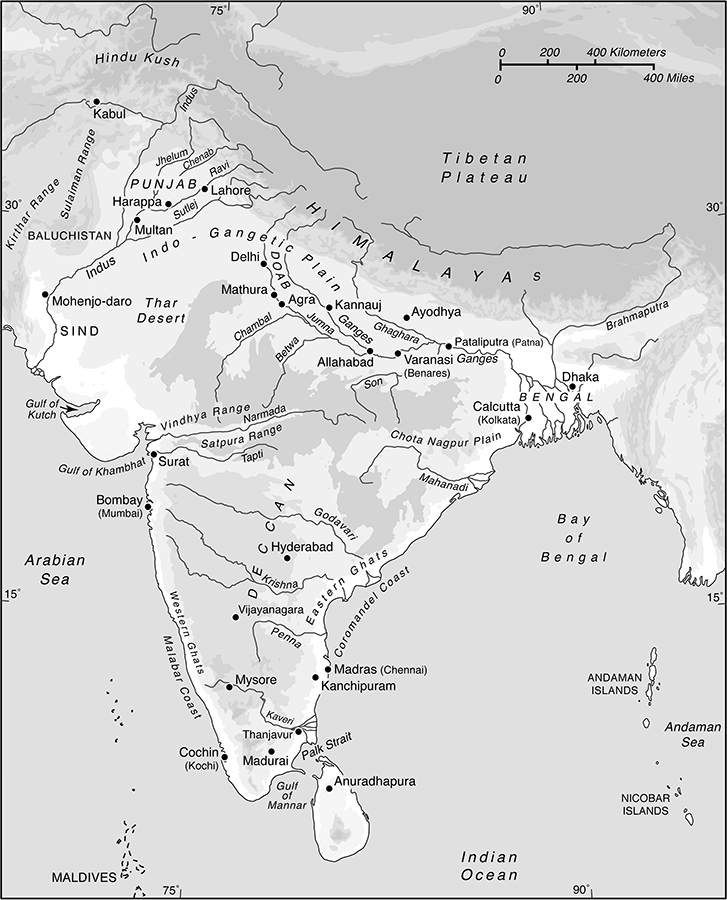
Map of the topography of the Indian subcontinent with selected sites
Note: The map shows a selection of topographical features and cities. The Himalayas form a massive barrier to much of Asia located to the north and east of the subcontinent. However, in the west and north-west there are passable routesfor example, through the Kirthar and Sulaiman mountain ranges. To the south of the Himalayas stretches the vast alluvial Indo-Gangetic plaincentred on the diverging Indus and Ganges river systems, which both have their origins in the Himalayas. In the east, the Brahmaputra joins with the Ganges in the delta of Bengal. Cutting the subcontinent roughly in two, the Narmada River winds its way westwards through the rocky Vindhya and Satpura hill ranges. Very broadly speaking, what is sometimes referred to as the north of the subcontinent is the area to the north and north-west of the Narmada River, while the south is the area to its south and south-east. With rich black soils, the elevated Deccan plateau comprises much of peninsular India. The Western and Eastern Ghats parallel the coasts and are essentially the edges of the Deccan plateau. Skirting the peninsular is the coastal plain, which is considerably narrower on the western side. The city sites shown include Harappa and Mohenjo-daro of the ancient Indus valley civilization, Lahore, Delhi, and Agra (the key Mughal cities), and the three colonial port-cities of Calcutta (Kolkata), Bombay (Mumbai), and Madras (Chennai). Other significant cities shown include Allahabad, Cochin (Kochi), Dhaka, Kabul, Kanchipuram, Madurai, Pataliputra (Patna), Surat, Varanasi (Benares), and the long-abandoned site of Vijayanagara.

Great Clarendon Street, Oxford, OX2 6DP, United Kingdom
Oxford University Press is a department of the University of Oxford. It furthers the University's objective of excellence in research, scholarship, and education by publishing worldwide. Oxford is a registered trade mark of Oxford University Press in the UK and in certain other countries
Tim Dyson 2018
The moral rights of the author have been asserted
First Edition published in 2018
Impression: 1
All rights reserved. No part of this publication may be reproduced, stored in a retrieval system, or transmitted, in any form or by any means, without the prior permission in writing of Oxford University Press, or as expressly permitted by law, by licence or under terms agreed with the appropriate reprographics rights organization. Enquiries concerning reproduction outside the scope of the above should be sent to the Rights Department, Oxford University Press, at the address above
You must not circulate this work in any other form and you must impose this same condition on any acquirer
Published in the United States of America by Oxford University Press 198 Madison Avenue, New York, NY 10016, United States of America
British Library Cataloguing in Publication Data
Data available
Library of Congress Control Number: 2018939591
ISBN 9780198829058
ebook ISBN 9780192564306
Printed and bound in Great Britain by Clays Ltd, Elcograf S.p.A.
Links to third party websites are provided by Oxford in good faith and for information only. Oxford disclaims any responsibility for the materials contained in any third party website referenced in this work.
This is a history of India written from a somewhat different perspectivethat of the population, its size, demographic features, and related characteristics. It begins with the arrival of the first modern people many tens of thousands of years ago, and ends with the situation a few years after the 2011 census.
The book is a brief introduction to an enormous and complex subjectalbeit one that has been rather neglected. Like any history, it assembles an account on the basis of what is known. But there are long periods of history for which very little is known, and what is thought to be known is tentative and fragmentary. Therefore, in bringing things together and joining them up, the book sometimes draws on unusual sources and follows an unconventional path. It is mainly when addressing the recent past that there has been much need to consider what topics might be omitted or pruned.
There is, of course, very considerable uncertainty about Indias population, especially in relation to the distant past. Indeed, much published general history about the country involves a fair amount of speculation. Inevitably, the present work is influenced by this. And the reader should also be cautioned about the use of numbers. They are all uncertain to varying degrees. Their inclusion here is frequently chiefly for purposes of broad illustration.
The present history is set within a framework whereamong other thingsrulers, dynasties, and empires rise and fall, territories are invaded, and battles and wars are fought. In general, then, it is a political frameworkone that is both helpful and used in the writing of many histories. However, it is also the case that, in the absence of hard evidence, political events can provide tentative clues as to what might have happened to the population. Moreover, even when considering recent decades it often makes sense to discuss events within their political context.
To write a population history of India covering such a very long period means that only central issues are addressed. Moreover, for much of the period the subcontinent is taken as a whole. Indeed, still wider geographical considerations are often germane. In this context, it is difficult not to remark on just how much of thevery littleinformation there is about Indias early population history derives from non-Indian (i.e. external) sources.
After 1947, of course, the focus here is very much on contemporary India, and population trends are discussed chiefly in relation to events within the country. However, as in most countries, in the last resort recent developments in India have often been very strongly conditioned by events in the wider world.
If Indias population history has been neglected, and one aim of this book is to join together pieces which lie scattered around, it is also the case that several scholars have made major contributions to the subjectfrom which, in places, this work draws freely. I mention, in particular, the important paper written by Leela and Pravin Visaria (Visaria and Visaria 1982) addressing the period 17571947, the stimulating collection of essays on past health and population trends written by Sumit Guha () which focuses mostly on the period 18711945. Other scholars whose work has had a substantial influence on the writing of this history include David Arnold, Mari Bhat, Jack Caldwell, George Erdosy, Arthur Geddes, Fabian Hirst, and Josiah Russell. I acknowledge too the particular influence of Irfan Habib. In providing general historical background I have also drawn on publications by John Keay, Barbara and Thomas Metcalf, Peter Robb, Burton Stein, and Romila Thapar, among others. The book has also benefited from helpful comments from anonymous referees.
Among many friends who have influenced me over the years in relation to this subject, I am particularly grateful to Jayant Banthia, the late Mari Bhat, the late Jack Caldwell, the late Nigel Crook, Monica Das Gupta, Arup Maharatna, S. Irudaya Rajan, Radhika Ramasubban, Gopinath Ravindran, Prem Saxena, K. Srinivasan, Leela Visaria, the late Pravin Visaria, and the late Avabai Wadia. I also want to record my appreciation of the various influences of Perianayagam Arokiasamy, Robert Cassen, Jean Drze, Christophe Guilmoto, K. S. James, Ramesh Kanbargi, Purushottam Kulkarni, Chris Langford, Michelle McAlpin, K. S. Natarajan, K. Navaneetham, Nandita Saikia, and Harish Srivastava, among others. Of course, in all cases the usual disclaimer applies. This is
Font size:
Interval:
Bookmark:
Similar books «A population history of India - From the First Modern People to the Present Day»
Look at similar books to A population history of India - From the First Modern People to the Present Day. We have selected literature similar in name and meaning in the hope of providing readers with more options to find new, interesting, not yet read works.
Discussion, reviews of the book A population history of India - From the First Modern People to the Present Day and just readers' own opinions. Leave your comments, write what you think about the work, its meaning or the main characters. Specify what exactly you liked and what you didn't like, and why you think so.

